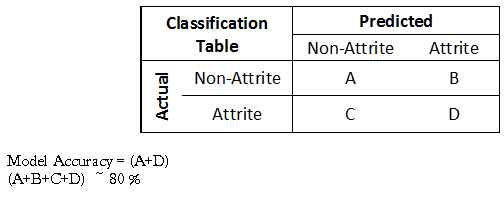Employee attrition is predictable under stable circumstances, wherein a set pattern can be deduced from certain parameters influencing the employee and the organization at all times. Some of these parameters could be foreseeable such as retirement age or unforeseeable such as company performance, external funding, management shakeup etc.
However, who is going to leave, when and why, can be answered based on analytical models developed as a result of data analysis.
By accurately predicting attrition risks of current employees, HR can take real steps to keep talent happy, engaged, and less susceptible to competitive overtures.
Attrition prediction helps in
- Churn Prediction: Create analytics models to identify employees at risk of leaving, so managers can rapidly change work conditions and behavior to keep top people from leaving.
- Attrition Root Cause: Correlate resignation with factors such as promotion wait time, pay increase, commute, performance, attendance, employee development, while cross referencing attrition variables with historic data and past resignations to see which indicators are the most relevant. Based on findings, you can begin effectively targeting and fine-tuning retention strategies.
- Resignation Segments: Compare how the resignation rate varies across locations, functions, tenure, age groups, diversity groups, and other variables, to ensure program investments are targeted where they will deliver the most significant results.
Through predictive algorithms, companies gain better understanding and can undertake preventive measures for employee attrition.
Selecting Prediction Model
On a basic level, the model works by clustering/ classifying employee profiles based on various attributes such as age, sex, marital status, education level, work experience, distance from hometown, etc. and generates various levels of risk of attrition. Occasionally, other parameters like performance over the years, pay raise, work batch, educational institution are also taken into consideration.
However, the accuracy of the model is directly proportional to the selection of parameters, which in turn, leads to the generation of the ‘type’ of predictive model most suitable for the organisation.
‘classification’ models catalog the employees based on their risk to leave the company; whereas ‘non-linear regression’ model gives the ‘probability of attrition’ when the outcomes are dichotomous.
decision trees’ model evaluate loss based on factors like gini index, information gain and variation reduction. For models involving multiple parameters, the decision trees tend to become very large and complex.
In such circumstances, ‘Random Forest’ method combines several decision trees using multiple algorithms to classify and understand complexities and predictions. Besides, these models aim to provide good predictability. However, seamless implementation depends on choosing the right model.
Thus, different models are chosen based on the aforementioned parameters, data availability, budget, computational power and the requirements of decision makers. For example, in one organisation, a model using artificial neural network may provide better predictability than a decision tree model, but a decision tree model may be easier to understand and implement at a lower cost.
Thus, depending on the organizational contexts, different models have to be tried and evaluated before making the final selection.
Model Output
The output depends on the chosen model. For instance, ‘logistic model’ produces scorecards for employees based on their predicted ‘attrition risk’ parameters; while the classification model catalogues the employees into wider parameters, such as-more likely or less likely to quit, high risk or low risk, etc.
However, the bottom line is to keep it simple enough for HR managers to understand and implement accordingly. Changing the various factors help in assessing the impact of changes and making the right decisions.
Genpact Example
Can attrition be prevented? How can one gauge the signs of flight risk long before a high performer starts looking for a new position? Is there a trend, any symptoms? The answer is YES. Diving deeper into the issue indicates that the employee-organization disconnect is not an overnight phenomenon. It starts long before an employee decides to quit. A systematic analysis of the same will definitely throw light on unforeseen factors enabling you to predict attrition. The ability to predict – Which employee will quit the organization, will help organizations in developing and improving retention strategies.
We were challenged with a similar kind of situation at Genpact Analytics & Research. To deal with the situation, we were required to predict employee attrition rate and the time interval during which an employee has the highest propensity to quit. As we started to devise solutions to handle the challenge, we realized the importance and power of Predictive analytics. In order to predict attrition, we started collating different data points at an employee-level, which may or may not directly affect attrition. After data cleansing, we worked on several statistical model iterations and finally decided to use Survival Analysis: Cox-proportional hazard model to predict attrition and identify the time interval when it is more likely to happen.
Using Cox-proportional model, we could classify employees into attrite and non-attrite class (with 80% accuracy).

The Cox model is beneficial to both the Retention and Recruitment Teams, along with predicting attrition rate it helps Operations Mangers and the HR department build retention strategies well in advance and eventually minimize the risk of employee turnover. Predicted risk scores for an employee, can help Recruitment teams to have suitable replacements on time and also prevent revenue leakage.
The power of analytics is thus proven; it can do wonders when implemented in varied Human Resource actions.

